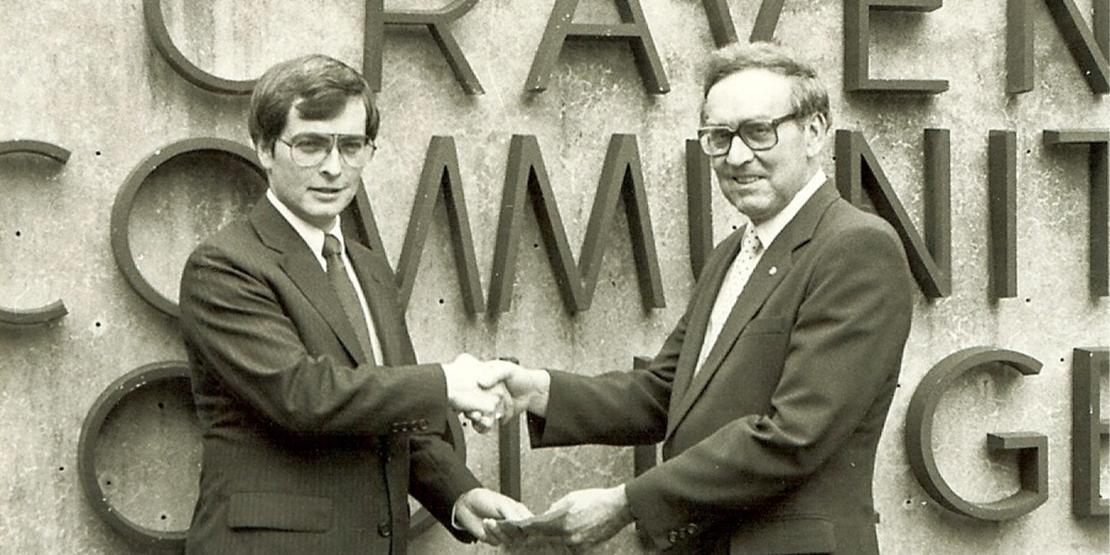Dr. Thurman Brock was a part of Craven Community College's story from the very beginning. His first day on the job was Aug. 15, 1961 as the inaugural Director of Vocational Education for Craven County Schools. He went on to become the College's first president, serving April 23, 1968–December 31, 1989.
To help preserve his institutional knowledge from those early years, Dr. Brock wrote an 18-part history of the College in 1984-85 for the school newspaper, "The Panther."
The article is intended to give the reader information about the North Carolina Community College System in general and Craven Community College in particular. It is my desire to share with you my thoughts and ideas, as well as specific and general information but you will find both informative and interesting.
The date was August 15, 1961, and the Craven County School System had just employed its first Director of Vocational Education. The Superintendent of Schools was Mr. R .L. Pugh. Mr. H. J. McDonald was Superintendent of the New Bern City Schools. Dr. Gerald B. James was State Director of Vocational Education.
John F. Kennedy was President and Terry Sanford was Governor. Jonathan Pharr was preparing to enter the third grade and Cliff Swain was entering high school tenth grade. Mr. George Ipock was Chairman of the County Board of Commissioners and Mr. Sam L. Whitehurst was our State Representative. Stallings Heating and plumbing was located in the building now occupied by Cotton Funeral Home; the Bern Restaurant was nonexistent (this location was a county crossroads at this time) and the Sears Catalog Store was located at the corner of Middle and Tryon Place Drive. The Tryon Hotel was across the street from the Heilig Levine furniture store and Derda’s Bakery was a popular donut and coffee shop located in the Hotel. Mr. C. A. Seifert was Chairman of the County School Board. This was the New Bern and Craven County that I discovered in 1961 as a new employee and resident of Craven County.
As a new Director of Vocational Education for the Craven County Schools, I began my first day with a pencil, legal pad and a small empty desk and office on Craven Street across from the County Courthouse. The only other school systems in our state to employ a local Director of Vocational Education were Wilmington-New Hanover Schools, Charlotte Mecklenburg, Asheville City Schools, and Greensboro City Schools. It was a lonely position at best since the concept was new and the local directors were few in number. The task was challenging – vocational education in Craven County consisted of Vocational Agriculture and Home Economics. There was one industrial arts teacher at Havelock.
However, my job assignment was to be twofold. First I was expected to provide the leadership for an expanded vocational program. Second, I was to promote adult education classes at night through the cooperation of the Lenoir County Industrial Education Center in Kinston.
Our first classes were held at Brinson Memorial School. Two of these first classes were Blueprint Reading and Basic Electronics. Mr. Cyril Edwards and his employees at Riverside Iron Works comprise the majority of students in the blueprint reading class. The telephone company had a majority of students in the electronics including a young man by the name of Sid Bartholomew. We provided the teaching space and the students; the Lenoir IEC provided the funds to pay the instructor for each class.
This was the beginning of what is now the Craven Community College. It was also the beginning of a much expanded vocational education program for the public schools. This initiation program began at the state level and Craven County was fortunate to be an early leader due to the foresight of Mr. R.L. Pugh. My time and energy was directed more and more to the adult education program although the public schools vocational program also grew in number. This public schools vocational education program growth was the result of a greater emphasis at the state level. Therefore, I cannot claim any significant credit for this area of growth and expansion. It did however make my job easier and allowed me more times to work with the adult education program.
Our adult education program continued to grow very slowly at first from 1961 through 1963. The seed was planted and it was time make a decision about the future of educational opportunities for adults in Craven County. More about this next time.
